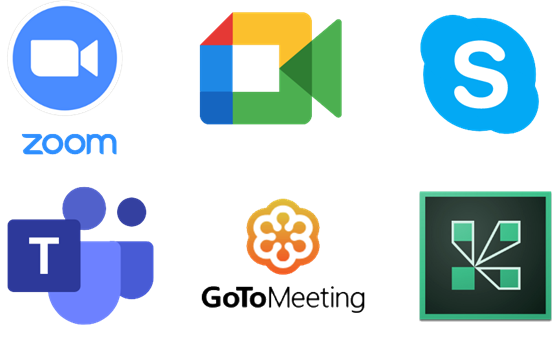While remote working and virtual networking are not new concepts, the take-up of these practices has been vital to many keen to develop new business, maintain existing business, and ensuring that many industries can continue to operate.
Posted Thursday, February 18, 2021

The first national lockdown may not have been shocking to many, it was still a culture shock to some people. We all started to increasingly miss the lack of social interaction with clients, prospective clients, face-to-face networking, and visiting shows and events as time has gone by. A digital solution was required for many to at the very least, maintain communication channels.
Who knew that there were so many video conferencing platforms: Microsoft Teams, Zoom, Google Meet, GoToMeeting, Skype for Business, and Adobe Connect to name but a few? The wide selection of online platforms helped us all to begin being able to reconnect to businesses, colleagues, and clients together virtually.

When the first lockdown morphed into tiered lockdowns and then a second lockdown, the more enterprising networking groups introduced break-out rooms in a successful attempt to make the networking meetings more interesting. This also had the advantage of increasing engagement and bringing even the shyest networker “into the room”.
As time has gone on, people have begun to learn more about their online conferencing tools. Using “Share screen” has become second nature for many and there are some people who take a delight in being able to show off their prowess at presenting online.
We are now in the middle of the third national lockdown, but there is light at the end of the tunnel. The trouble is we do not know how long the tunnel is at the moment! So, if you have yet to embrace the online world of networking, selling, and account management, it is not too late to do so.
Why? Well, once we are out the other side of the lockdown and can meet clients face to face again, we don’t know what that process will initially look like. Will all members of networking groups want to meet face to face? Will clients and prospective clients welcome us into their offices? Or will we be organising even more meetings over a coffee at our favourite coffee house or hotel?
Either way, remote working, and online networking will not be going away any time soon. For the next 9-12 months, networking will likely a mix of face-to-face and people joining meetings online. Business travel will likely remain localised and regionalised. Businesses that have gotten used to not paying hotel bills for overnight stays and expenses for their staff will more than likely want to keep a tight watch on expenses such as these.
Overseas business travel will slowly start to increase, but who knows when it will get back to previous levels if indeed it does. So, it makes sense to ensure that your online presentation skills are honed to perfection.
By presentation, we do not just mean a pretty PowerPoint or whatever presentation software you use to support your sales conversation, it is more about how you present yourself overall throughout the networking or sales meeting – and it's worth remembering even in the online world first impressions still count.
As do all the other things that you would previously do for face-to-face networking or sales meeting:
Prepare, Prepare, Prepare!

With such a plethora of video conferencing platforms, it is easier said than done but by learning to fully utilise the platforms that you are most likely to come into contact with, you can maximise the visual communications tools the platforms have to offer.
Look at your environment, in other words, what will people see when you are on screen. Many of the platforms have a preview tool in which you can view what your environment will look like to others during the session.
A good background is key, there is not a lot of visual space to play with, but at the very least you should display your company logo on a plain background. If the platform allows, make sure to add your name to the display screen name settings.
We have all seen the posts on social media about people presenting in their pyjama bottoms and slippers, with a jacket and tie on top that the camera can see, but it is important to be presentable and not look too relaxed!
While there is a casual element to online networking consider that is also a business setting. Remember to smile and be aware that making eye contact can be difficult because you do not know where you might appear on someone else’s screen. As you can see in the image below, people have got their personal presentation bit covered, but not the background or their names on the screen.

There is no point attending a networking event unless you intend to get fully involved. Be focussed, try to take part in the conversations, and be seen and heard in making a positive contribution to the meeting. Say hello to everyone in the chat, make sure to introduce yourself with your business name and contact details, and ask everyone else to do the same so that at the end of the meeting you can copy the chat from the meeting into a word document so that you have a record of everyone who has attended and can circulate the document if needed. There are no business cards, so look at this as your opportunity to distribute your business card.
Preparations are key to success in the online virtual conferencing space there are additional things you should do in advance of an online meeting. Most networking meetings allow you to speak for 60 seconds presenting your business. If it is your first time at a particular meeting don’t try and put everything your business does into 60 seconds, the audience will remember little or nothing of what you say. Think what is the main business problem you solve for customers or clients and concentrate on that.
If you are a member of a networking group and the other people in the meeting have heard a “60 seconds” from you before, change your 60 seconds on a regular basis and if possible, make it topical. For example, if something in the news affects the sector you are in or your clients’ businesses, demonstrate how your business has responded to the news.
At the end of the networking meetings, there is generally time for you to say the business you would like an introduction into, be as specific as possible, name names or at the very least the job titles you would be interested in contacting.
The meeting has now finished, but it is not job done. You should, as soon as you are able, make sure to follow up your new contacts and connect with them on LinkedIn and other social media channels that are relevant to your business.
The next step is then to set up 1-to-1s with these new contacts. Make sure you have a 1-to-1 with everybody you have contacted and connected with. It is your opportunity to learn about other attendees’ businesses and see how you can help them. At the same time, you can tell them everything about your business. Be sure you listen to them first and before telling them about your business.

If you want to pitch your business effectively make sure to follow the 60-second elevator pitch rule. There has been a growth in speed networking. This is where everybody who has enrolled in the networking event gets a chance to talk with everyone else, you guessed it for 60 seconds, in a 1to1 environment. The time is strictly controlled so you do need to condense what you are saying into 60 seconds as you will automatically be cut off after the time has passed.
Again, after a speed networking session, connect with your new contacts on LinkedIn and arrange more in-depth 1-to-1s. You can connect with us on LinkedIn easily by simply clicking @astutemediauk.
If you would like to arrange to meet up virtually and discuss your online and marketing needs and requirement, you can drop our accounts manager Bob Mountford an email on bob.mountford@astutemedia.com or call him directly on: 07551976490 to arrange an online chat.